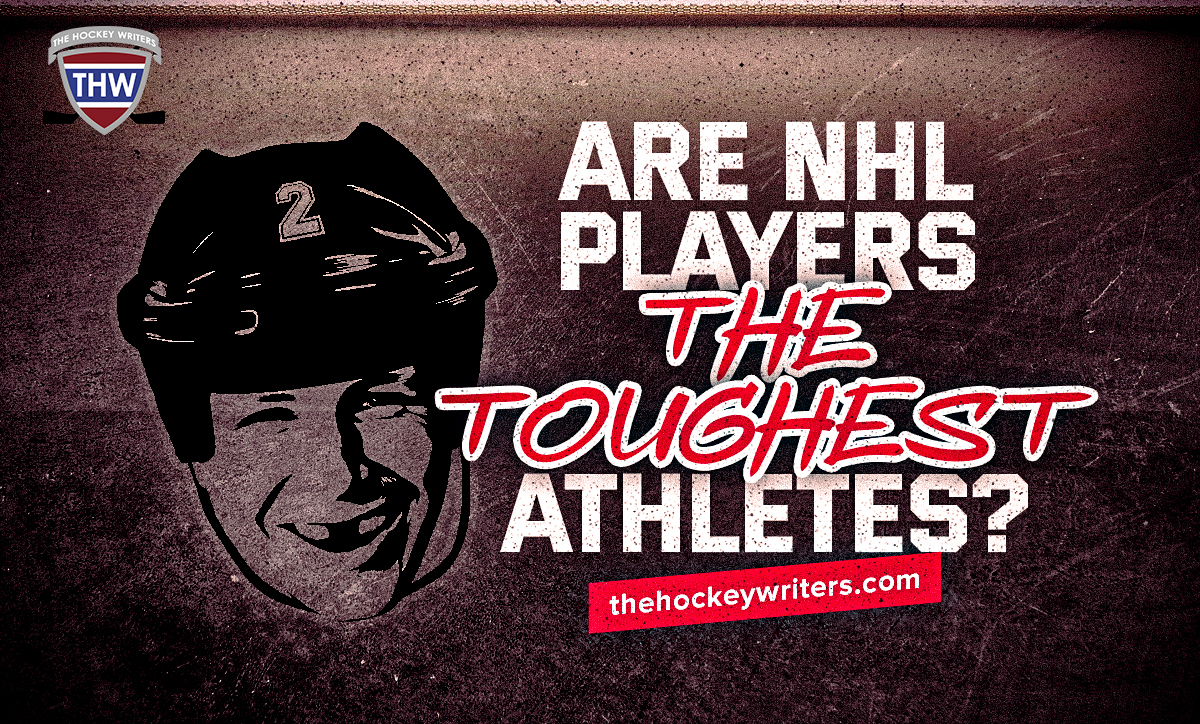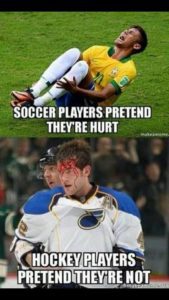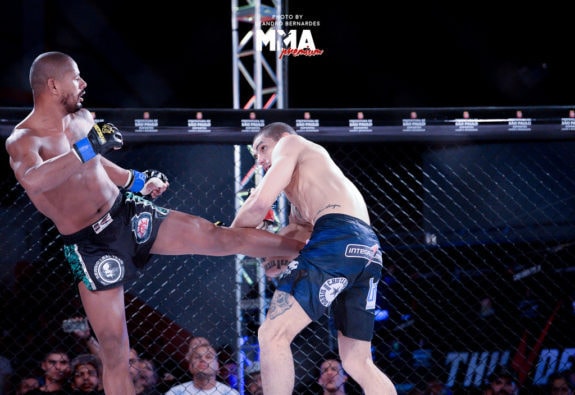Professional athletes train hard. They often endure brutal conditions and workout routines in an attempt to fine tune their bodies for physically demanding sports. They’ll put everything on the line to succeed and be their best. But which sport is the most physically demanding? Some rely heavily on an optimized cardiovascular system. Others rely on speed, strength or agility. So, who are the toughest pro sports athletes in the world?

Comparing Athletes’ Toughness
According to an extensive study done by ESPN called Sports Skills Difficulty, ice hockey ranks second behind only boxing among the 60 sports measured. Football is ranked third, basketball fourth, baseball ninth and soccer tenth. The least tough athletes competed in bowling, curling, billiards and, understandably ranked dead last, fishing.
RELATED: Our Latest NHL Rumors Stories
The panel of eight experts was made up of sports scientists from the United States Olympic Committee, of academicians who study the science of muscles and movement, of a star two-sport athlete, and of journalists who spend their professional lives watching athletes succeed and fail. They study measured ten categories: endurance, strength, power, speed, agility, flexibility, nerve, durability, hand-eye coordination, and analytic aptitude.
This article compares athletes from many of the major sports.
Hockey Players
Hockey players are a different breed of athlete and they’ve proven that time and time again. Players compartmentalize their pain, especially come the playoffs, for the lure and thrill of winning the Stanley Cup.
The two final teams battling for the prized hardware will each have played more than 100 games of competitive hockey. There’s a few pre-season games, a long and seemingly never-ending 82-game regular season, and several rounds of playoff action. Each game is filled with vicious body checks, hits into the boards, high sticks, cross-checks, slashes, blocked shots and fights.
Along the way, there are broken noses, broken jaws, stitches, separated shoulders, concussions, high-ankle sprains, black eyes and countless other injuries.
Whether the swelling and human destruction comes from a deflected puck, blocking a Shea Weber slapshot, an errant stick, an intended stick, Radko Gugas being Radko Gudas, or hitting a concrete wall the likes of Zdeno Chara, Tom Wilson or Dustin Byfuglien, pain soon follows.
Playing Through Pain
Tales of playing through pain are many. In 1964, Bobby Braun blocked a Gordie Howe shot with his ankle and fell to the ice. Despite breaking several bones in his ankle, Braun continued playing on it thanks to a “tight tape job.” The game went into overtime, and of course, Baun scored the game-winner forcing a game seven.
Montreal Canadiens’ Bob Gainey won a Stanley Cup against the Isles while playing with both shoulders separated. He didn’t tell anyone until the playoffs were over.
In the 2013 playoffs, Gregory Campbell of the Boston Bruins blocked a blast from Pittsburgh Penguins star Evgeni that broke his fibula. He picked himself up, then finished killing off the rest of the penalty.
Last year, after the Pens won their second straight Cup, 28-year-old defenseman Ian Cole admitted he played with a broken hand and broken ribs in the final two rounds. He averaged a little over 18 minutes per game. Nick Bonino blocked a P.K. Subban shot in the first period of a playoff game that broke his tibia. Not only did he play out the game, he attempted to dress for the remaining games, but his coach did not allow it.
Baseball Players
Baseball players “tweak” things and are out a month. A starting pitcher can miss a few starts with a blister or an ingrown nail. They hit the disabled list faster than an Ovechkin wrister finding the back of the net.
A hot grounder can give an infielder a shiner. Pitchers can ding a player to send a message. Goose Gossage said if a batter dug in at the plate he’d bury them in that hole. In 1992, pitcher Tom Glavine once cracked two ribs and was forced onto the disabled list. The reason? He puked up his in-flight meal.

There are countless examples of baseball players getting injured during what seems like routine, everyday, innocent plays.
Boxers vs. Hockey Players
The training boxers undergo before a fight is intensive and demanding. Still, boxers only fight one to three times a year depending on their opponents’ availability and the extent of their injuries following a combat.
While boxing is much more demanding on a short period of time (12-round fight), the hockey season is much more strenuous on a professional athlete because players typically log 20 minutes of ice time, game after game, during more than 80 games per year over 15- to 20-year careers. Oh, and hockey players fight on skates. Let’s see a boxer do that.
Football Players vs. Hockey Players
Football can be a physically brutal sport. However, according to a Wall Street Journal study of four television broadcasts, and similar estimates by researchers, the average amount of time the ball is in play on the field during an NFL game is about 11 minutes of actual playing time over a 60-minute game. And the season includes only 16 games plus the playoffs, so football is more about brute force, speed and strength, not so much about durability and endurance.
Heck, football players play only one game per week, while hockey players often have to play back-to-back games or three contests in four nights… in different cities! Moreover, the NFL Players Association indicates that the average football player’s career is only three seasons long.
Even former Pittsburgh Steeler player, Willie Colon believes hockey players are tougher than football players.
Basketball Players vs. Hockey Players

(Karen Rigsby/Pinterest)
Karl Malone, who sits second overall on the NBA’s all-time scoring list (behind Kareem Abdul-Jabbar), bashed his way to nearly 37,000 career points. Somehow, he never suffered a major injury in the process. Malone shunned all the pads that today’s players wear. “I had one of my [players] today and he had body armor from his thigh to his neck. I ask him what he was doing and he said he was protecting himself. I said ‘Who you protecting yourself [from]?’ There’s no sniper in this building! Man up! If you’re hurt, see the trainer and play the game.”
Basketball players these days don’t hold a candle to hockey players. Basketball players cry and whine at every call, and act like babies if someone’s elbow brushes past them. A leg cramp was enough to have Lebron James carried off of the court by medical staff during a game. A Detroit Pistons‘ player who was out for three weeks due to tooth pain. C’mon, bruh. Man up.
Hockey players don’t wait for the dentist during the game; they are the dentist. Be it a stick to the face or pulling them out themselves, like Ryan Reaves did a few years ago on the bench, it’s not if but when their smiles become jack-o-lantern-like. They’ll pull that tooth out right then and there and then pretend they didn’t even get hit in the face in the first place.
Soccer Players

Soccer players play a rigorous 90-minute game. According to match reports from the 2010 World Cup, in the average 90-minute match, the average actual playing time in a soccer game was about 68 minutes. With the large size of the playing field, most of the time soccer players are not directly involved in the game. That said, soccer requires speed. A combination of all-out sprinting often separates players from the ball to gain position on a field as large as 21,000 square feet.
Soccer isn’t very physical. Most contact is forbidden and often results in a yellow or red card. Physical contact usually ends up with one player trying to draw a free kick or a penalty by diving on the turf and writhing like stunned newborn llamas feigning severe injury. Come within a foot of their toes and they’ll roll around and act like they have been shot by a bazooka. Or they’ll often flop around like a fish out of water, desperately wanting a call to go their way.
All too often players will twist a knee or an ankle and need to be carried off on a stretcher. They’ll then return to the game two minutes later. Dude. Just hop off the field under your own power.
Rugby
Rugby requires a good of endurance like soccer, as it’s a nonstop running game that lasts 80 minutes. At the same time, it is a hectic contact sport almost like football. The hits are often brutal. It’s like football without pads. Rugby players will tell you that football is for pansies who aren’t brave enough to play their sport.
UFC/MMA Fighters
Sport is not about trying to maim or cripple or render your opponent unconscious. This is. At its core, it’s barbaric. That said, Ultimate Fighting Championship/mixed martial art fighters are tough. They have to master martial arts as well as elements of wrestling and boxing. They spend time weight training to get stronger and still have to make their weight class before every matchup.

Regardless of the extensive training and preparation, once in the ring, these athletes can have the snot beaten out of them, break a limb, bust open a brow, and catch multiple elbows in the face just for blinking at the wrong time. Fighters must maintain an unparalleled level of physical and mental alertness to avoid falling victim to a technically perfect fight-ending blow from an opponent. When you enter the ring or cage, your life is in your hands; when you leave, it may be splattered all over the floor or discovered on X-rays to have been shattered in many pieces. It’s extreme.
The Toughest: Hockey Players
Athletic toughness is often depends on culture–of the sport, the team, and the country in which it’s being played. Most athletes have some degree of toughness, whether they are wearing padding or not, or diving and flopping around. They also have an amazingly high threshold of pain.
To us, there’s no doubt hockey players are the toughest athletes on the planet.
Just ask Patrice Bergeron. He suffered torn rib cartilage in Game 4 of the 2013 Stanley Cup Final, a broken rib on his left side in Game 5 and a separated right shoulder and a punctured left lung in Game 6. The puncture eventually caused the lung to collapse, and Bergeron ended up in the hospital following Game 6, spending three days there.
It’s a lot of hard work to race around on a sheet of ice for 60 minutes, even with line changes every minute or so. Intense shifts of high-intensity effort, quick starts, stops, direction changes, fighting for loose pucks, and hard hits add up. The interval nature and physicality of the game makes it uniquely demanding endurance wise. Plus, the whole game is played while standing on a steel blade about 1/8” thick.
Hockey players need to have skill and agility. They need to have all the moves and skills of basketball, soccer and other sports, but do it all on skates, often backwards. Ice hockey players are the toughest athletes on the planet and have to endure the harshest physical beating to win the Stanley Cup. It’s another reason why hockey is the best sport on Earth.

it should be “turf toe” not toe turf LOL.
I think one could make the argument that NFL quarterbacks are pretty tough. These guys get hit by 300+ pounders whose job it is to decapitate the QB 10-12 times a game. At the end of the day it’s MMA fighters that are the toughest, but hockey players would mop the floor with Basketball players, baseball players and the woman’s ringette teams!
I would love to see Sports Science attack this one. Would be interesting. Great piece!
Can you people oweners and players , get the season started…. money money , ok I DON, T GET IT…. WHAT DO THEY WANT? get the show on the road…..